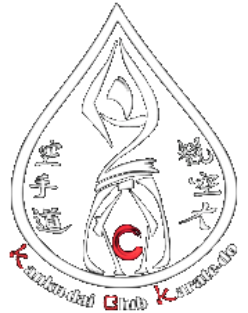Belt degrees
Lower ranks, kyū (級), are ten, each one with a different belt color. The ordering is the traditional of Japanese karatedo:
10th 級 → white belt
9th 級 → white/yellow belt (only for children who attended children preparatory courses)
8th 級 → yellow belt
7th 級 → orange belt
6th 級 → green belt
5– 4th 級 → blue belt
3rd– 1st 級 → brown belt
The promotion from a kyū to the former one is achieved after an exam, usually at the end of the season (June), only if the person has attended at least 70% of classes in his/her course.
The higher ranks, dan (段), are ten, but the belt color is always black, even though some other organizations sometimes assign a white/red belt for dan higher than 5th.
The higher dan attainment, stated that it is only for personal use and satisfaction, for whom worked to improve his/her technical and human aspects, follows the popular custom:
1st 段 → after at least one year since 1st kyū
2nd 段 → after at least two years since 1st dan
3rd 段 → after at least three years since 2nd dan
4th 段 → after at least 4 years since the previous one
5th 段 → after at least 5 years since the previous one
For the subsequent ranks, the nomination is yielded by a wider technical committee, in agreement with the candidate.
Academic titles, such as Trainer, Teacher, Sensei, etc., are available only through specific formative classes organized by public or State institutions.
Technical committee

KCK Desio technical committee, whose purpose is the formation and preparation of the active members, is composed by:
Roberto Colombo, sensei, President of the committee
President’s role is to supervise, monitor and educate the instructors, for they may fulfill their duties at best.
He decides upon social activities of the Association.
President personally teaches to children preparatory courses, sport course and advanced black belts.
Riccardo Bruno (t.m.)
Tiziano Siligato (instructor)
Davide Salvagio (coach)
They decides the syllabus, the examination programs and work together to reach their annual target.
Act to make members work together, cure the relations with parents, welcome and manage the new entries.
They together teach in kids’ and adults’ classes.
Technical committee is supported by the Association Council, which helps organizing all the collateral activities necessary to the Association’s social purpose, such as: formative classes, training, seminars and so on.

